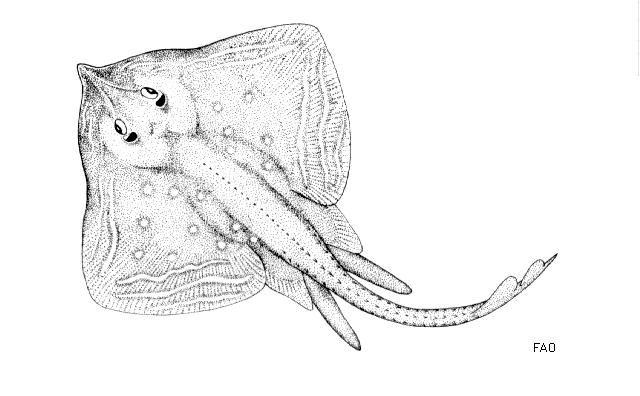Raja microocellata
Montagu, 1818
Small-eyed ray
Classification: Elasmobranchii Rajiformes Rajidae
Reference of the original description
An account of several new and rare species of fishes, taken on the south coast of Devonshire, with some remarks on some others of more common occurrence. Memoirs of the Wernerian Natural History Society, Edinburgh, 2, 413–463
An account of several new and rare species of fishes, taken on the south coast of Devonshire, with some remarks on some others of more common occurrence. Memoirs of the Wernerian Natural History Society, Edinburgh, 2, 413–463
Synonyms / new combinations and misspellings
Raia microcellata, Raia microocellata, Raja microcelata, Raja microcellata, Raja microocelata, Raja (Raja) microocellata
Raia microcellata, Raia microocellata, Raja microcelata, Raja microcellata, Raja microocelata, Raja (Raja) microocellata
Description :
Citation: Raja microocellata Montagu, 1818: In: Database of modern sharks, rays and chimaeras, www.shark-references.com, World Wide Web electronic publication, Version 12/2025
Please send your images of "Raja microocellata" to info@shark-references.com

Raja microocellata Montagu, 1818, © FAO, www.fish-base.org

Raja microocellata Montagu, 1818, © FAO, www.fish-base.org
Common names
 Hellfleckiger Rochen,
Hellfleckiger Rochen,  Kleinäugiger Rochen,
Kleinäugiger Rochen,  Raia colorada,
Raia colorada,  Raya,
Raya,  Raya colorada,
Raya colorada,  Raya de ojos,
Raya de ojos,  Raie mêlée,
Raie mêlée,  Owl ray,
Owl ray,  Painted ray,
Painted ray,  Painted skate,
Painted skate,  Small-eyed ray,
Small-eyed ray,  Smalleyed ray,
Smalleyed ray,  Smalleyed skate,
Smalleyed skate,  Razza,
Razza,  Arrai,
Arrai,  Paia-zimbreira,
Paia-zimbreira,  Raia,
Raia,  Raia-zimbreira
Raia-zimbreira
 Hellfleckiger Rochen,
Hellfleckiger Rochen,  Kleinäugiger Rochen,
Kleinäugiger Rochen,  Raia colorada,
Raia colorada,  Raya,
Raya,  Raya colorada,
Raya colorada,  Raya de ojos,
Raya de ojos,  Raie mêlée,
Raie mêlée,  Owl ray,
Owl ray,  Painted ray,
Painted ray,  Painted skate,
Painted skate,  Small-eyed ray,
Small-eyed ray,  Smalleyed ray,
Smalleyed ray,  Smalleyed skate,
Smalleyed skate,  Razza,
Razza,  Arrai,
Arrai,  Paia-zimbreira,
Paia-zimbreira,  Raia,
Raia,  Raia-zimbreira
Raia-zimbreira
Short Description
Eyes conspicuously small; dorsal fins close-set, no thorns between; upper surface predominantly spinulose, underside almost smooth in young, but head and centre of disc prickly in larger specimens; orbital thorns separate, a regular row of about 50 thorns from nape to first dorsal fin; upper surface greyish, olive to light brown with light blotches and long bands, underside white [7182].
Eyes conspicuously small; dorsal fins close-set, no thorns between; upper surface predominantly spinulose, underside almost smooth in young, but head and centre of disc prickly in larger specimens; orbital thorns separate, a regular row of about 50 thorns from nape to first dorsal fin; upper surface greyish, olive to light brown with light blotches and long bands, underside white [7182].
Distribution
Eastern Atlantic: southwestern England and Ireland to Rio de Oro in Western Sahara; absent from the North Sea and the Mediterranean. Source: www.gbif.org
Eastern Atlantic: southwestern England and Ireland to Rio de Oro in Western Sahara; absent from the North Sea and the Mediterranean. Source: www.gbif.org
Human uses
fisheries: minor commercial; gamefish: yes; price category: medium; price reliability: questionable: based on ex-vessel price for species in this genus
fisheries: minor commercial; gamefish: yes; price category: medium; price reliability: questionable: based on ex-vessel price for species in this genus
Biology
Oviparous [7182]. Paired eggs are laid. Embryos feed solely on yolk [733]. Distinct pairing with embrace. Young may tend to follow large objects, such as their mother [17086].
Oviparous [7182]. Paired eggs are laid. Embryos feed solely on yolk [733]. Distinct pairing with embrace. Young may tend to follow large objects, such as their mother [17086].
Size / Weight / Age
80.0 cm TL (male/unsexed; (Ref. 41333)); 86 cm TL (female); max. published weight: 4,500 g (Ref. 4699)
80.0 cm TL (male/unsexed; (Ref. 41333)); 86 cm TL (female); max. published weight: 4,500 g (Ref. 4699)
Remarks
shark-references Species-ID=5701;
shark-references Species-ID=5701;
Parasites (arranged by Jürgen Pollerspöck)
Conoidasida
Monogenea
Cestoda
Nematoda
Copepoda
- Holobomolochus sp. [9086]
Conoidasida
- Haemogregarina delagei Laveran & Mesnil, 1901 [21437]
Monogenea
- Acanthocotyle lobianchi Monticelli, 1888 [15273]
- Calicotyle kroyeri Diesing, 1850 [17150] [15273] [9086]
- Empruthotrema raiae (Maccallum, 1916) Johnston & Tiegs, 1922 [15273] [17002]
- Merizocotyle undulata (Kearn & Beverley-Burton, 1990) Chisholm, Wheeler & Beverley-Burton, 1995 [9086]
- Rajonchocotyle emarginata (Olsson, 1876) [15273] [15243] [17450] [9086]
Cestoda
- Acanthobothrium sp. [9086]
- Acanthobothrium tripartitum Wiliams, 1969 [16448] [28741]
- Acanthobothrium uncinatum (Rudolphi, 1819) [9086]
- Crossobothrium sp. [9086]
- Echeneibothrium sp. [9086] [33185]
- Echinobothrium brachysoma Pintner, 1889 [9086]
- Grillotia erinaceus (Van Beneden, 1858) [16112]
- Grillotia sp. [9086]
- Nybelinia lingualis (Cuvier, 1817) [9086]
- Onchobothrium pseudouncinatum De Beauchamp, 1905 [16408]
- Onchobothrium sp. [33185]
- Phyllobothrium lactuca Van Beneden, 1850 [9086]
Nematoda
- Anisakis simplex (Rudolphi, 1809) [9086] [33185]
- Histodytes microocellatus Aragort, Alvarez, Iglesias, Leiro & Sanmartín, 2002 [10848] [9086]
- Hysterothylacium sp. [9086]
- Metanisakis baylisi (Gibson, 1973) [9086]
- Phocanema sp. [33185]
- Piscicapillaria (Piscicapillaria) freemani (Moravec, Margolis & Mcdonald, 1981) [9086]
- Proleptus sp. [9086] [33185]
Copepoda
- Trebius caudatus Krøyer, 1838 [23942]
















